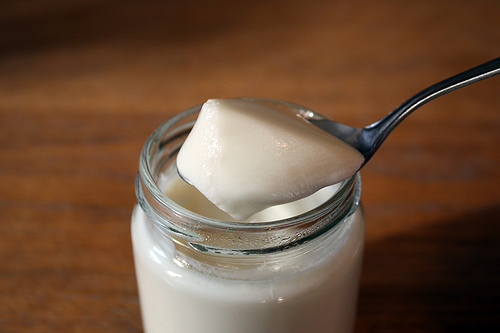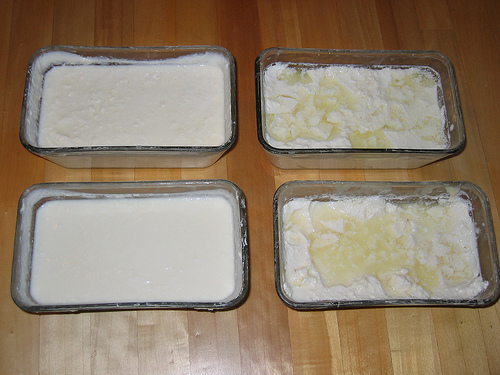
I don’t like that title but it’s true. As I will explain in a later post you can’t trust commercial yogurt makers to provide much bacteria in their yogurt — they actually seem scared of the stuff. So I made yogurt myself. It turned out a lot better than I expected.
I had made yogurt dozens of times. This time, however, I wanted to get as much bacteria as possible so I incubated it about 24 hours instead of about 6 hours. It came out far more sour (due to lactic acid) than ever before. But it wasn’t just really sour (like vinegar); it also had complexity of flavor, creaminess, and a pleasant consistency. It was more sour (tart and tangy are the conventional terms) than any yogurt I’ve ever had. I couldn’t eat a bowl of it; I had to eat it with other food. This may be why commercial yogurt is mild: So you will/can eat more of it at one time.
The yogurt I made is essentially a condiment, although it can be mixed with fruit. It improves almost anything: soup, meat, fish, fruit, string beans, scrambled eggs. (Because almost nothing we eat is sour and almost nothing we eat is creamy.) It is better than other common condiments, such as mustard and chutney, because of its creaminess. It is also far cheaper than other condiments. A small bottle of mustard might cost $3. The same volume of homemade yogurt would cost about 10 cents. (You might need twice or three times as much yogurt to get the same effect.) It is far easier to make than other condiments. And, above all, I suspect it is infinitely better for your health. Mustard has few bacteria. If you complexify and sour your food with mustard, you are essentially chewing ice.
Because of subsidies, milk in California is extremely cheap. Ordinary milk, to me, is nearly worthless; I never buy it. Now, with little effort, this very cheap product that I have completely ignored is the source of something like liquid gold — at least, if you like good-tasting food and health.
Recipe. I took a gallon of whole milk, mixed it with 2 cups of powdered milk, heated it at about 200 degrees F. for 10-20 minutes (I’m unsure if this step is necessary), cooled it down to 130 degrees F., added 1/2 cup of starter (from other yogurt), and then incubated it in my oven at about 110 degrees F. for about a day. I divided the mixture into four glass containers. Although the lowest possible setting on the oven is “WARM”, which was too hot, the thermostat actually works at lower temperatures. I set it below WARM and used a room thermometer to adjust the setting so that the temperature was about 110 degrees. (The photo above is not mine, incidentally. My yogurt is no longer photogenic.)
Thanks to Saul Sternberg for help with the recipe.
 All yogurt recipes I’ve seen say you should preheat the milk before adding starter (= yogurt with live culture). Reasons vary. Some say it denatures the milk protein; others say it kills bacteria that might compete with the starter bacteria.
All yogurt recipes I’ve seen say you should preheat the milk before adding starter (= yogurt with live culture). Reasons vary. Some say it denatures the milk protein; others say it kills bacteria that might compete with the starter bacteria.